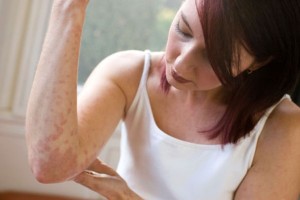Rashes in adults appear as changes in skin color and texture, which may occur as a result of allergies, infections, cellulitis and acne. Rashes in adults may be localized, which means only a single region of the body is affected, or generalized, which means several regions of the body is covered with rashes.
Symptoms that may indicate the presence of rashes include skin color changes such as red, 
Important Disclaimer: this post on rashes in adults is for information purposes only. To learn more about how to recognize and manage rashes and the complications that can be associated with them sign up for workplace approved first aid training.
Causes
- Allergies
- Athlete’s foot
- Acne
- Chicken pox – rare in adults
- Eczema
- Hives
- Jock itch
- Irritant dermatitis
- Pityriasis rosea
- Ringworm
- Poison ivy
- Seborrheic dermatitis
- Viral rashes – herpes zoster, herpes simples, mononucleosis
Rashes in adults may also occur due to diseases and illnesses such as:
- Diabetes
- Dermatomyositis
- HIV infection
- Psoriasis
- Lupus
- Sarcoidosis
- Rheumatoid arthritis
- Scleroderma
Bacterial infections that may cause rashes include:
- Cellulitis of the face, ear, hand, arm, foot, leg, abdomen or breasts
- Lymphangitis is the arm, leg, or hand due to wounds
- Impetigo
- Meningococcemia
- Scarlet fever
- Skin abscess – Lyme disease
Signs and symptoms of rashes in adults
- Skin color changes – red, white, black or brown
- Texture and skin surface changes – raised, flat, moist, crusty, scaly, peeling of the skin
- Blisters
- Dry skin
- Hives
- Skin bumps and lumps
- Pus drainage
- Tenderness of the skin
- Swelling
- Skin ulcers
If you report your condition to your doctor, he may carry out the necessary treatment depending on the cause of the condition. Treatment for rashes in adults generally includes taking medicated baths, using skin moisturizers and corticosteroid creams, taking oral corticosteroids, antihistamine medication for itching and antibiotics for infection, and phototherapy.
Treatment
Follow these home care tips to ease the symptoms of rashes:
- For red, itchy, scaly or flaky rashes, apply 1% hydrocortisone cream on the rash. Apply the cream 4 times a day
- Wash your skin at least twice a day
- Use hypoallergenic soaps and cosmetics
- Avoid scratching the skin as it may increase the chances of infection. If you do scratch your skin, wash your hands thoroughly with soap and water before touching anyone or anything
- Avoid exposure to substances that may worsen the rashes
- Avoid sun exposure by wearing fully covered, light-weight clothing and hats and using protective sunscreen
- For dry skin use moisturizers
- In case of moist rashes, keep your skin dry. Change your clothes if they are wet and wear loose-fitting, light-weight cotton clothes to reduce sweating
- Take antihistamines to reduce itching
- See your doctor if rashes are persistent and take the prescribed medication as directed. Avoid skipping doses as it may make the medication less effective
- Familiarize yourself with the common side effects of prescribed medication.
Learn More
To learn more about recognizing and managing rashes and associated complications enrol in a workplace approved program (find a course).
Related Video
http://www.youtube.com/watch?v=6WFi1UAY5Zg
